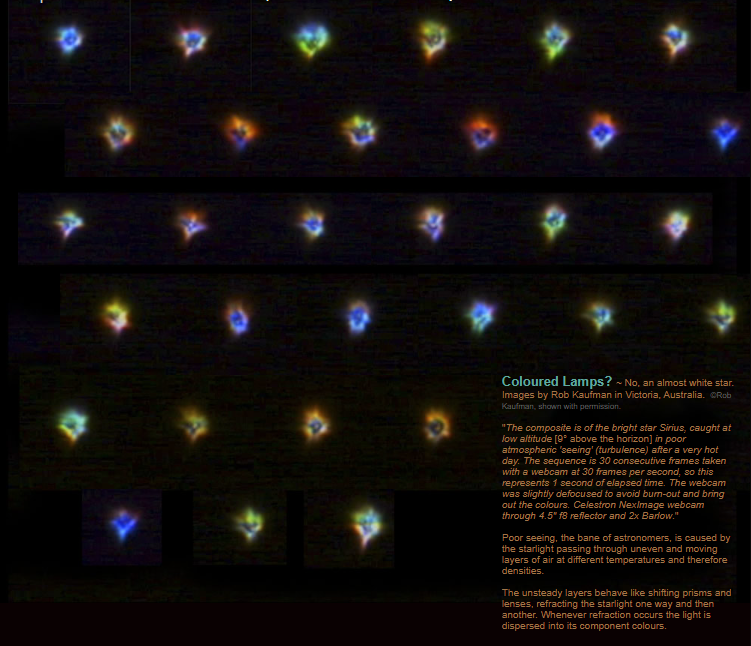Coloured Lamps?
Coloured Lamps: Unveiling the Secrets of Atmospheric Optics
Have you ever wondered why stars sometimes appear to have different colors? In the realm of atmospheric optics, this captivating phenomenon is not the result of colored lamps, but rather the complex interplay between starlight and our Earth's atmosphere. Today, we will delve into the intriguing world of poor seeing, which can cause stars to shimmer and showcase a vibrant array of hues.
The Intricacies of Poor Seeing
Poor seeing, a constant challenge for astronomers, arises from the interaction between starlight and the ever-changing layers of air in our atmosphere. These layers possess varying temperatures and densities, creating an uneven and turbulent environment. As starlight passes through these turbulent layers, it undergoes refraction, similar to the way light bends when it passes through a prism.
A Dance of Prisms and Lenses
The unsteady layers of air act as shifting prisms and lenses, bending and distorting the starlight as it traverses through them. This dynamic process causes the light to refract in different directions, leading to a dispersion of its component colors. Consequently, stars that would normally appear white to our eyes can exhibit a stunning display of colors when observed under conditions of poor seeing.
The Elusive Star: Sirius
To illustrate this phenomenon, let us turn our attention to the bright star Sirius, captured in a remarkable sequence of images by astrophotographer Rob Kaufman in Victoria, Australia. These images depict Sirius at a low altitude of 0.9° above the horizon, taken under poor atmospheric seeing conditions following an exceptionally hot day.
Unveiling the Hidden Colors
Kaufman used a Celestron NexImage webcam mounted on a 4.5" f/8 reflector telescope, along with a 2x Barlow lens, to capture the images. To avoid overexposure and to enhance the colors, the webcam was intentionally defocused. This defocusing technique allows the camera to reveal the intricate hues hidden within the star's light.
The Temporal Tapestry of Color
The sequence of images captured by Kaufman spans 30 consecutive frames, taken at a rate of 30 frames per second. Incredibly, this represents just one second of elapsed time. As we examine these frames, we witness the mesmerizing dance of colors as the starlight traverses the turbulent layers of the atmosphere. It is a fleeting spectacle that reveals the complexity and beauty of atmospheric optics.
Exploring Further
While this article provides a glimpse into the captivating world of colored stars under poor seeing conditions, there is much more to explore within the realm of atmospheric optics. By studying these atmospheric phenomena, astronomers gain valuable insights into the behavior of light and the intricacies of our atmosphere.
To dive deeper into this fascinating subject, you can explore the original article by visiting the source link. There, you will find a wealth of information on various atmospheric optical phenomena and the incredible images captured by passionate astrophotographers.
Conclusion
Colored lamps? Not quite. Instead, we have discovered that stars can exhibit an astonishing array of hues due to the effects of poor seeing and atmospheric optics. Through the lens of a skilled astrophotographer, we are granted a glimpse into the dynamic interplay between starlight and our ever-changing atmosphere. So, the next time you gaze at the night sky and witness a star shimmering with vibrant colors, remember the secrets unveiled by atmospheric optics – a mesmerizing tapestry woven by nature itself.

Coloured Lamps? ~ No, an almost white star. Images by Rob Kaufman in Victoria, Australia. ©Rob Kaufman, shown with permission.
"The composite is of the bright star Sirius, caught at low altitude .9° above the horizon. in poor atmospheric 'seeing' (turbulence) after a very hot day. The sequence is 30 consecutive frames taken with a webcam at 30 frames per second, so this represents 1 second of elapsed time. The webcam was slightly defocused to avoid burn-out and bring out the colours. Celestron NexImage webcam through 4.5" f8 reflector and 2x Barlow."
Poor seeing, the bane of astronomers, is caused by the starlight passing through uneven and moving layers of air at different temperatures and therefore densities.
The unsteady layers behave like shifting prisms and lenses, refracting the starlight one way and then another. Whenever refraction occurs the light is dispersed into its component colours.
Note: this article has been automatically converted from the old site and may not appear as intended. You can find the original article here.
Reference Atmospheric Optics
If you use any of the definitions, information, or data presented on Atmospheric Optics, please copy the link or reference below to properly credit us as the reference source. Thank you!
-
<a href="https://atoptics.co.uk/blog/coloured-lamps/">Coloured Lamps?</a>
-
"Coloured Lamps?". Atmospheric Optics. Accessed on April 26, 2024. https://atoptics.co.uk/blog/coloured-lamps/.
-
"Coloured Lamps?". Atmospheric Optics, https://atoptics.co.uk/blog/coloured-lamps/. Accessed 26 April, 2024
-
Coloured Lamps?. Atmospheric Optics. Retrieved from https://atoptics.co.uk/blog/coloured-lamps/.